Вы здесь
History of Bukhara.

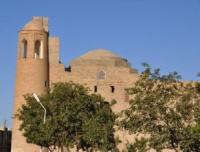
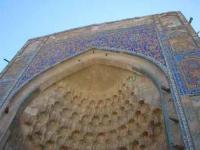
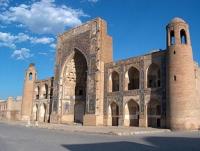

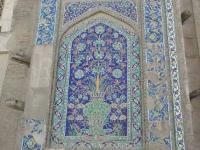
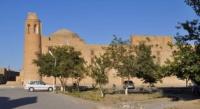
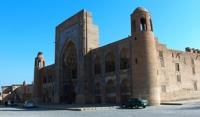
Tours to Bukhara and over Central Asia.
"He expanded the Sheibanid empire, founded by Genghis Khan's grandson Sheiban, to Tashkent, Fergana, Khorasan and Khorezm. The empire did not last long: in the XVII century it lost most of its dominions, shrinking back to what was later called the Khanate of Bukhara"
Tour packages to Uzbekistan.
The earliest remains of human presence in Bukhara are to be found at a depth of about 20 meters an indicator of how long appoximately the town has been in existence. Various documents and scholars fix Bukhara's beginnings at 2000 to 3000 years ago. It is known that in 329 B.C.
Alexander the Great conquered a town in this area. The name Bukhara starts appearing in written documents from the I century A.D. The city's could be derived from the Persian "bukhar" for "the source of knowledge" or the Sanskrit "vihara" for "monastery".
We can assume, that right from the start, Bukhara was a place where scholars gathered, where science and beautiful crafts stood high on the lists of achievements of its residents and citizens.
Before the Arabs arrived it was ruled by the Achaemenids, the Greeks, Seleukids, Parthians and Kushans, though it never served as any of their capital. By the time of Arabs invasion in 712, Bukhara with its location on a major crossroads had evolved into a large wealthy center of trade. Initially, the Arabs were met with great resistance, alas, furious, albeit disorganized rebellions in the end came to nothing.
Some of the richest merchant families fled. Islam replaced all other beliefs. The X century saw the real rise of Bukhara. With a population even outnumbering its current 250, 000 it was the capital, cultural and religious center of the Samanid Empire, which covered the whole of modern Uzbekistan, Tadjikistan and a large part of Afghanistan and Iran.
Over two hundred Medresses attracted students from all over the Muslim world, from Arabia to Morocco. Its libraries rivaled those of Baghdad itself. But all that was ended by Kharakhanids who invaded in 999.
The only remaining monument of that time is the Emperor's Mausoleum, as pictured here, for some reason left untouched by the Kharakhanids and later by even by Genghis Khan.
Ghengis Khan's hordes reduced most of Bukhara to dust and smoldering rubble in a blink of an eye; the population was massacred.
Only the Kalyan mosque and minaret were spared. Bukhara lost all it had prided itself on and for centuries resembled no more than a shadow of its former self. It did not re-emerge until the XVI century when it was rebuilt by Abdullah Khan.
He expanded the Sheibanid empire, founded by Genghis Khan's grandson Sheiban, to Tashkent, Fergana, Khorasan and Khorezm. The empire did not last long: in the XVII century it lost most of its dominions, shrinking back to what was later called the Khanate of Bukhara.
Since then, Bukhara has seen many rulers and several dynasties coming and going. The last dynasty was that of the Mangits, who ruled until 1920, when communists took over. In 1832 Bukhara was visited by Alexander Burnes,a British officer, who compiled "Travels into Bukhara", perhaps the most colorful and detailed description available for western readers in the XIX century.
From his notes we know that at that period Bukhara's population barely exceeded 150,000, less than half as many as during its glory days before the Mongol invasion. Still it remained the center of religious education with over three hundred Medresses and thousands of students, whose tuition and maintenance were largely subsidized by the government.
Emir Nasrullah was in power at that time, best known for imprisoning and then beheading two British officers, only ten years after Burnes' voyage. The 1860s and 1870s saw turbulent times in Bukhara. In 1868 what we would now term extremist Muslim clergy declared jihad against Christian Russia, which was steadily infiltrating the region.
The Russian general Kaufmann, having gained control of Samarkand, continued on to Bukhara, but wary of attacking it right out he instead took control of its water sources. The Muslim clergy incited a revolt against the Emir who clearly could not offer any serious retaliation against Russian forces, even if he so desired.
Under these circumstances, Kaufmann's entering the city appeared as a legitimate act of assistance to the Emir. In 1873 the Emirate of Bukhara officially became one of Russia's dominions.
After the revolution of 1917 in Russia, Bukhara became the headquarters for counter-revolutionary action, In September 1920, after a month of siege and bombardment, the Red Army occupied the city.
Bukhara became the capital of the formally independent Bukharian People's Republic, but even this very limited autonomy did not last long, and in September 1924 was turned into one of the Soviet Republics through which the city may have lost its standing as a mainstream religious and educational center, but it also gained a lot.
The eradication of the Guinea worm, a water parasite, irrigation systems which allowed for sheep farming, factories processing local cotton, wool and karakul fur and gold embroidery provided employment and world renown.
The once crumbling Medresses and historical monuments are carefully restored. Lyabi Hauz square with the pool and its blue tapchan seatees is the perfect hang out and photo background.
The old town's narrow lanes now lead to charming small B&B's for every budget, some of them boutique hotels, where in the traditional court yards you can unwind over a cup of tea after a visit to the trading domes, where souvenirs, carpets, crafts and curiosa from all over Central Asia are for sale; or you can observe an artisan producing beautiful items, from jewelry to miniature painted boxes, there are quaint museums to bring you the long and rich history closer, many located at The Ark; Mir Faiz will tell you all about the spices he sells, there's a photo gallery, the Art Gallery, evening entertainment with folk dance and fashion show, gorgeous jackets that fit and will get you lots of oh's and ah's back home.
You may join a Shashmakom traditional music rehearsal, try your skills at gold embroidery or work with the Gijduvan Ceramics Narzullaev Family for a few days. An outdoor pool, a tennis court, a sport stadium with running track, saunas, massage, await the health conscious.
And wherever you walk and stand, locals will be delighted to have a chat with you, get your views and opinions, to tell you a legend, a joke, an interesting fact. Ultimately, the people of Bukhara are like nowhere else, and they make the charm of this very unique place on earth.
Authority:
Anton Kovalenko. http://www.discovery-central-asia.com
Photos by
Alexander Petrov.







